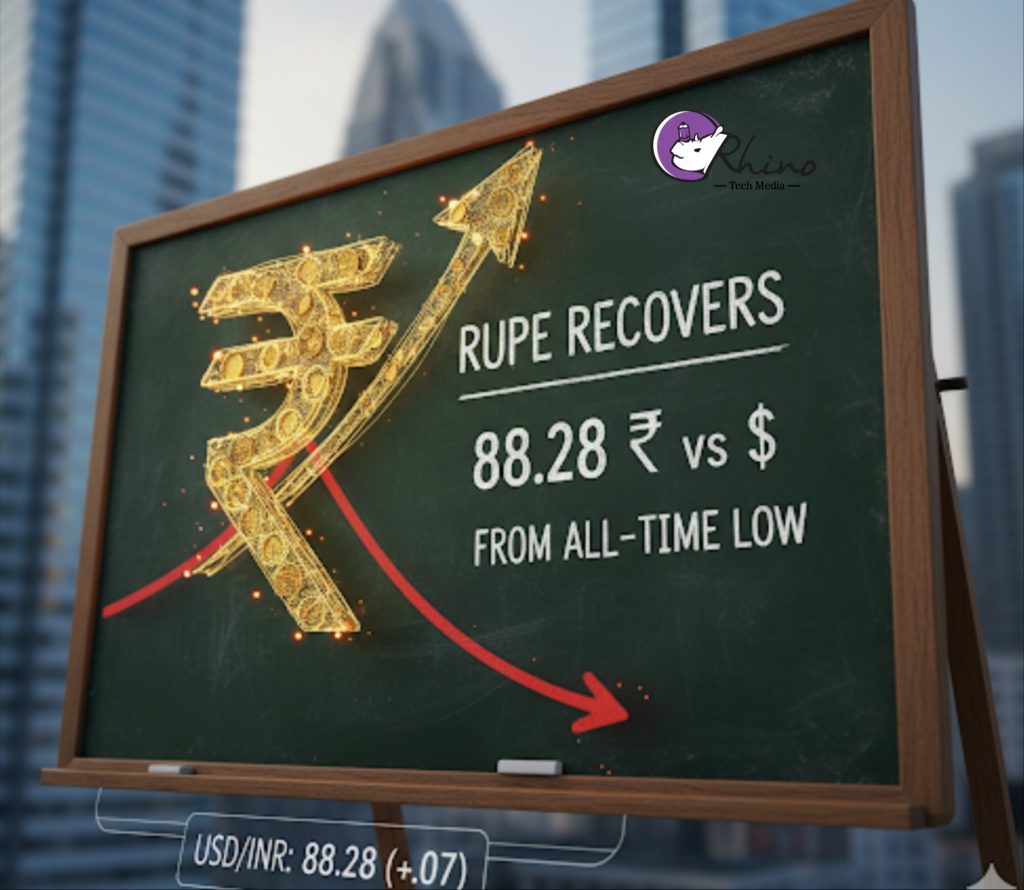The Recent Movement
On Friday, the Indian rupee recovered seven paise from its all-time low level to close the day at ₹88.28 against the U.S. dollar. Earlier, on the previous trading day (Thursday), the rupee had slumped by 24 paise, closing at an all-time low of ₹88.35. During that session, it had also touched a new intraday low (≈ ₹88.49) before some recovery.
Thus, the recovery to ₹88.28 represents a modest but notable bounce, in the context of recent depreciation. The trading sessions have been volatile, with a tight range forming around the all-time low levels.
Contributing Factors
Several factors appear to have contributed to both the decline and the partial recovery of the rupee:
- Weakness in the U.S. Dollar Index & Fed Policy Expectations
The rupee’s recovery is in part attributed to some softening of the U.S. dollar index, which reduces the upward pressure on USD/INR when the greenback strengthens globally. Also, there is market sentiment that the U.S. Federal Reserve might soon cut rates, which tends to weaken the dollar. - Tariff-Led Pressure & Trade Tensions With the U.S.
Ongoing tariff issues between India and the U.S. have weighed on investor confidence, especially affecting exporters. This has created continued demand for the dollar and acted as a drag on the rupee. - Foreign Portfolio Outflows
Investors have been withdrawing funds from Indian assets, putting more pressure on the rupee. Large outflows reduce demand for the rupee and increase demand for foreign currency. - Domestic Market Sentiment & Equity Markets
The domestic equity markets showed strength (Sensex and Nifty rose) during the day of recovery, which likely helped investor risk appetite, encouraging some rupee buying. - Oil Prices and Import Demand
While not emphasized as the primary cause in the report, global crude oil prices and importers’ demand tend to influence the rupee: high oil prices increase India’s import bill, increasing dollar demand. Any moderation or expectations thereof help ease pressure.
Implications
The rupee’s partial recovery, though small, has several implications:
- Psychological Benchmarking / Support Levels: The all-time low levels (≈ ₹88.35 and intraday dips near ₹88.49) become psychological and technical points of resistance or support. Recovery from those levels suggests some investors see value or believe the depreciation may have become overextended.
- Policy Attention: Such sharp depreciations draw attention from policy makers (Reserve Bank of India) and the government. Measures may be considered to limit volatility, such as intervention in the currency market, monetary policy tweaks, or adjustments to trade and tariff policy.
- Import and Inflation Pressure: A weaker rupee increases the cost of imports (especially oil, fuel, raw materials). Even marginal recoveries help, but unless the currency stabilizes, there could be inflationary pressures feeding through to consumer prices.
- Export Competitiveness: On the flip side, a weaker rupee can improve competitiveness of Indian exports, making them cheaper abroad. However, that effect is limited if the depreciation is driven by risk factors rather than structural shifts.
- Investor Sentiment: Stability or modest recovery after a fall can help bolster market confidence. But the sharp falls also undermine trust—investors may demand premium for currency risk or hedge more aggressively.
Risks & Uncertainties
While the recovery is a positive sign, there are several persisting risks:
- Sustained Foreign Outflows: Unless the trend of capital outflow reverses, pressure on the rupee could continue.
- Tariff / Trade Policy Uncertainties: The ongoing trade frictions, and any new tariffs, could again weigh heavily on exports and FX inflows.
- External Shocks: Oil price spikes, global dollar strength (especially if Fed holds rates high), or geopolitical tensions could reverse the rupee’s gains.
- Inflation & Import Costs: Russia, China or other trade partners’ raw material/export-price fluctuations can feed into inflation if the rupee weakens further.
- Range-Bound Movement: Given the tight trading range around ₹88.00-₹88.50, the rupee may remain volatile without strong triggers.
Outlook
Looking ahead, the rupee’s path may be influenced by:
- Upcoming U.S. economic data, especially inflation figures, which will affect Federal Reserve rate expectations. A dovish Fed might weaken the dollar and help the rupee.
- Developments in India–U.S. trade negotiations, which could mitigate tariff pressures. Positive outcomes could improve investor sentiment.
- Domestic policy actions: RBI interventions (currency markets), fiscal/monetary policy to manage external deficits and inflation.
- Global risk appetite: If global markets become more risk-on, emerging market currencies like the rupee tend to benefit. Conversely, risk-off episodes hurt them.
Conclusion
The rupee’s recovery of seven paise to ₹88.28 from its all-time low reflects a mild rebound after investor concerns and external pressures had pushed it down sharply. While the move is small in absolute terms, it is meaningful psychologically and could hint at stabilization if supported by favorable global developments, improved trade relations, and inflows. That said, substantial risks remain: trade tensions, foreign outflows, import pressure, and global dollar strength could easily re-push the rupee toward or past recent lows. For now, the rupee seems to be in a precarious balance — able to recover marginally, but vulnerable to adverse external or domestic shocks.

